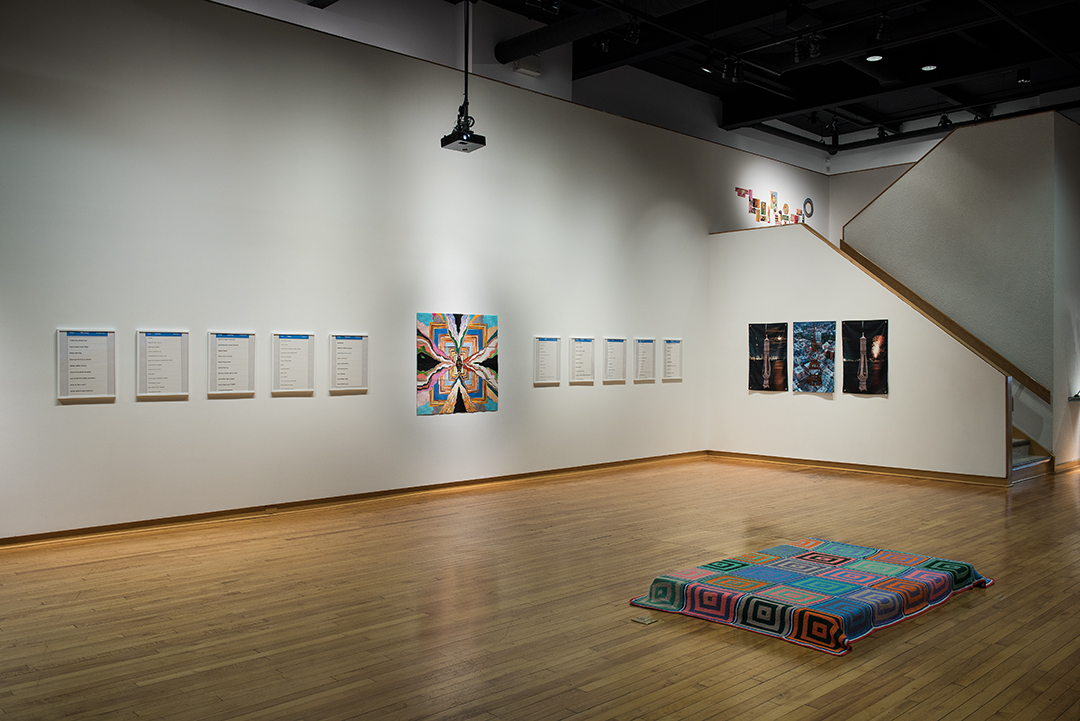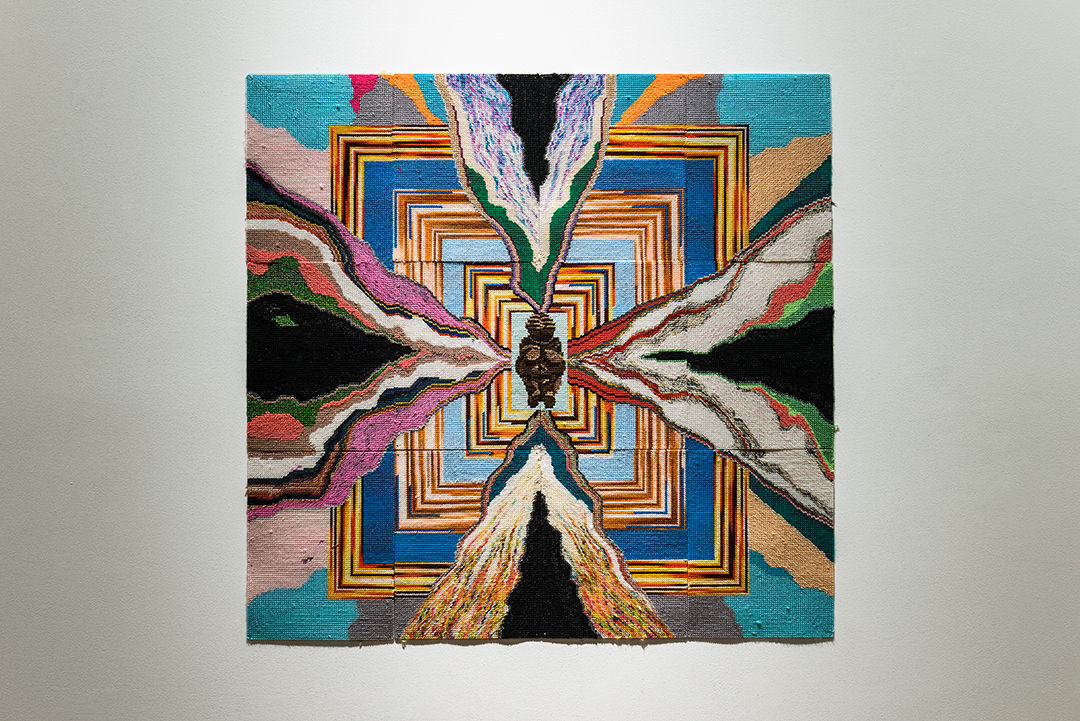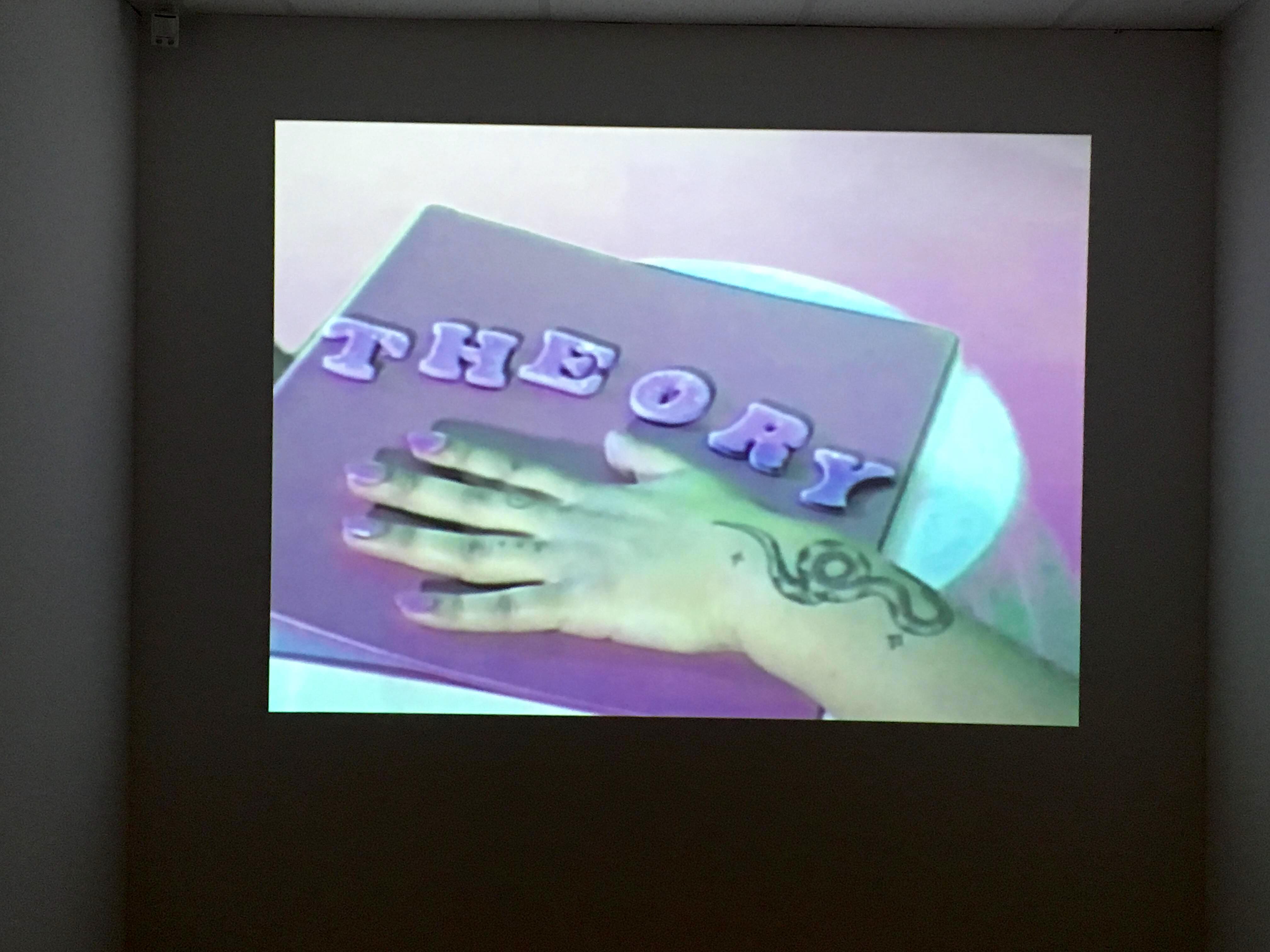What Motivates Her? Madelyne Beckles and Allyson
Mitchell at the Thames Art Gallery
January 18 – March 10, 2019
Review, June 4, 2019 by Adrien Crossman
 Buzzkill
Emotional Gateway(2019). Photo courtesy of GXZ Design Inc and the Thames Art Gallery
Buzzkill
Emotional Gateway(2019). Photo courtesy of GXZ Design Inc and the Thames Art Gallery Intergenerational dialogues among artists, women, feminists, queer people, and racialized folks are vital for communities to grow and learn – with the hopes of keeping both sides aware of the varying contexts and points of view that stem from coming of age at different times. Throughout my academic and artistic career, my practice has been deeply impacted and informed by the established makers and thinkers in my community who have paved the way not only for the kind of work I make but for my ability as a young queer artist to be taken seriously. The importance of cross generational dialogues, especially within marginalized communities, seems to be recognized as vital to many artists and institutions alike, but how does one go about forging such connections? These kinds of relationships are sometimes addressed through select residencies and mentorship programs, yet many of these opportunities are through invitation or involve a competitive application process.
For Madelyne Beckles and Allyson Mitchell the connection was organic, they are aunt and niece, and their show at the Thames Art Gallery in Chatham, Ontario this past winter was the first time they had collaborated. What Motivates Her? was a two-person exhibition curated by Pamela Edmonds that explored intersectional feminism, sexuality, social stigmas, queerness and race. Both artists work in a number of mediums including video, textile, sculpture, installation and print, and they use humour, while intertwining pop culture imagery with references to literature and theory, to address contemporary anxieties around politics and identity.

Close Proximities (2019). Photo courtesy of GXZ Design Inc and the Thames Art Gallery

Installation view. Photo courtesy of GXZ Design Inc and the Thames Art Gallery
Upon entering the gallery, I was greeted by a set of gold velour curtains – unsure if this plush material was part of the exhibition or merely there to serve an aestheticized utilitarian purpose of keeping out the mid-winter cold. The main exhibition space featured two new collaborative works, Buzzkill Emotional Gateway (2019), an installation of lit disco balls suspended in different coloured macramé hangers hung from the very high ceiling, and Close Proximities (2019), a large-scale video projection accompanied by a soft quilted lounging area. Surrounding these works were individual pieces by both artists. As I moved through the exhibition, Mitchell’s recontextualization of traditional craft and art historical references in works like Venus of Chillendorf (2018), and the personal act of reading as political (Reading Eileen (2018)), provide a contextual counterpart to Beckles’ satirical approach to theory (Theory of the Young Girl (2017)), and the very relatable Search Herstory (2015 ongoing), in which the artist makes public her internal digital monologues through the archiving of google searches.

Venus of Chillendorf (2018), Allyson Mitchell. Photo courtesy of GXZ Design Inc and the Thames Art Gallery
 Second floor installation view. Photo
courtesy of GXZ Design Inc and the Thames Art
Gallery
Second floor installation view. Photo
courtesy of GXZ Design Inc and the Thames Art
Gallery
Apart from traveling across the border to Detroit, What Motivates Her? was one of the most nuanced and successfully executed exhibitions I’ve seen in the region south of London since moving to Windsor in 2016. There are common challenges when exhibiting at a regional gallery located outside of larger metropolitan art hubs. One hurdle is attendance and audience engagement. The Thames can feel quite vast - it is a re-appropriated gymnasium with high ceilings and an open concept second floor. The crowd at the opening was sparse, feeling as if there were almost as many staff members as visitors. The benefit being that I was able spend time chatting with the Mitchell and her partner and creative collaborator Deirdre Logue, and to meet and speak with Beckles. I also had the time and space to intimately engage with the work - a next to impossible feat in the context of a crowded opening. The drawback is in those who did not or could not attend. Understandably, there was another opening taking place in Windsor that evening, and when travelling from out of town, the Thames is most easily accessible by car.

Pagina Ceramic Studies 1-6 (2016), Allyson Mitchell Allyson Mitchell. Photo courtesy of GXZ Design Inc and the Thames Art Gallery

Theory of the Young Girl (2017), Madelyne Beckles.
Another potential barrier is that more politically and/or conceptually oriented exhibitions may run a higher risk of agitating the local population – or at the very least of being misunderstood. Institutions brace for this in different ways. Installed near the entrance of the dark alcove displaying looped video, there was a wall didactic, the text serving as a statement cautioning that some of the works may offend or provoke a range of feelings in the audience, and that the artists welcome a dialogue, but they nevertheless “defend the freedom to create content and exhibit such works anywhere in the world”. I appreciated the sentiment, but found its inclusion odd, causing me to wonder whether a statement like this may incite a reaction rather than prevent one, leading audiences to believe that there is something worth reacting to. Should regional institutions like the Thames be giving their audiences more credit, or was the text in response to a previous incident?

The Whole Woman (2018), Madelyne Beckles. Photo courtesy of GXZ Design Inc and the Thames Art Gallery
The didactic, I later found out, was a compromise made between the artists and the institution and not something that would normally accompany their work. It was prompted by concerns that the brief nudity and inclusion of certain language may not be suitable for all audiences. I see this as a clear example of the need for artists such as these to be exhibited in centres like the Thames and regions like Chatam-Kent (with a population of just over 100 000 and located an hour outside of both Windsor and London).
Mitchell and Beckles both challenge harmful stereotypes and communicate from an intersectional feminist perspective exploring issues surrounding race, gender, and queerness. The success of their work relies in part on how they take on challenging subject matter while creating accessible entry points through use of inviting aesthetics, humour and the recontextualizing of familiar imagery and pop culture. Works such as Beckles’ Search Herstory perfectly encapsulate a specific feeling of millennial anxiety in the digital age, while Mitchell’s practice spans decades of political and art historical discourse while remaining urgent and contemporary.
There is much to be learned by both those who came before us and those who come after. Beckles and Mitchell have the privilege of blood relation, yet intergenerational dialogue is a critical factor in the continual growth and evolution of intersectional politics and the overall prosperity of marginalized communities. Mentorship can prove challenging outside of institutional frameworks, yet it is something we need to continually work toward in our increasing fraught political landscape. In a time that can feel overwhelming bleak, exhibitions like What Motivates Her? provide nourishment while inviting us to have some of these ‘difficult’ conversations in a productive way – to call in rather than call out – something I hope to see much more of in the near future.
